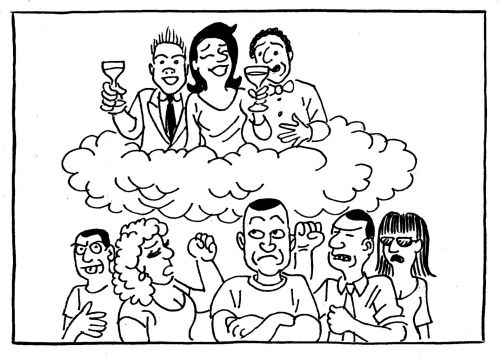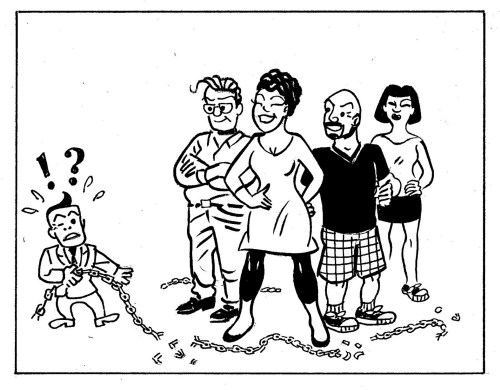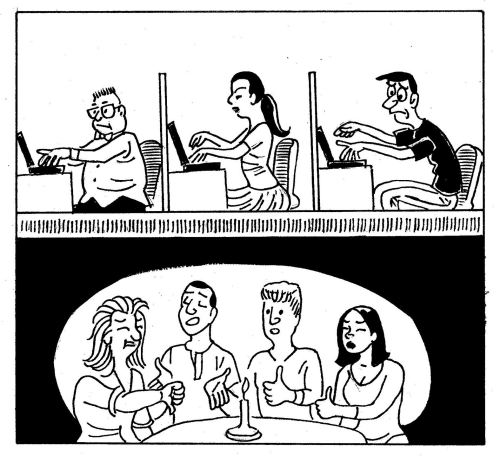Constructive subversion: a guide to organizational change
- December 7, 2013
Anarchism & Autonomy
Do not fret, anarchists! Pockets of horizontalism can be carved out of hierarchy, and once liberated, even NGOs can be turned into spaces of autonomy.
- Author
How anarchists end up in charities
Work: it’s one of the hallmark contradictions faced by anarchists in capitalist society. We don’t believe we should have to do it, but we know how hard it can be to stay afloat in a transactional world without a certain amount of income coming in. All but the most hardcore of us accept jobs of some kind, as ‘necessary evils’ of life under capitalism.
In an attempt to minimise the contradiction, anarchists often opt for ‘the lesser of three evils’ (the other two being government and business), finding jobs in NGOs, charities and trade unions that have at least a theoretical alignment with some of the things we believe in. Gradually we find ourselves not just in the lowest organisational ranks, but scattered at various levels around campaigns, IT, research, and supporter services teams. In a strange twist of fate, our practical organising experiences offer us considerable advantage in these settings, creating the double contradiction of not only working a job, but of finding ourselves in the ranks of management from time to time!
While we go into these organisations aware of the contradictions with our broader politics, once inside we often go in one of two directions:
- We gradually buy into the incremental reforms they offer, bit-by-bit leaving our grassroots organising work behind, while becoming increasingly jaded by the dehumanising experience of hierarchy; or
- We treat our jobs as any other form of wage slavery, mindlessly punching the clock and keeping our evenings and weekends free for the real action.
What can we do about it?
I think there’s an alternative. I call it ‘constructive subversion.’
It lies in our ability to ‘hack’ these hierarchical reformist organisations we spend our days in, weaving networks of subversion to undermine the bureaucracy, and ‘prefiguring’ radical pockets (creating microcosms of wider change) within and around the existing structures.
In other words, we bring our wider politics into our workplaces and create spaces and relationships that can operate beyond organisational control.
 Could we actually transform traditional organisations via constructive subversion?
Could we actually transform traditional organisations via constructive subversion?
Maybe, maybe not.
The range of organisations out there varies too dramatically in terms of politics, size, history and investment in the status quo, to say definitively, one way or the other. The challenge of making the Red Cross or Save the Children into participatory democracies, is a considerably different challenge than to do so in many smaller organisations, with more staff who have experienced horizontalism in grassroots organising work (and thus are less-likely to accept as much top-down authority).
What I do believe – and have seen and experienced – is that pockets of autonomy can be carved out of hierarchy, and that more radical work can be done in those spaces, once liberated. Organisational IT teams are my favourite example of this, often having a culture (and physical space) that is all their own, considerably less-restrained by the politics and structures found in the rest of the office. This is in significant part because few others in the building actually have a clue what they do, but is also because they’ve rarely relied on formal channels to create autonomous spaces. As a result, a range of more self-organised approaches have begun to take root around countless organisations, as people slowly begin to see the wider relevance of ‘tech solutions’ such as agile methods, ‘hack days,’ and open and free software.
Is this worth our time?
I’ve decided to write about this for two reasons:
- Many of us already spend 40+ hours a week in these organisations, twiddling our thumbs or slowly forgetting that we can’t change the world without changing the unequal social power dynamics most organisations perpetuate. Neither is ideal and we shouldn’t accept them as inevitable. Therefore, why not try to do something outside the Non-Profit Industrial Complex playbook and see if we can put the time, effort and resource of these institutions to use for something better than it otherwise would be?
- There are lots of people who don’t identify themselves as anarchists, but who are nonetheless fed up with the soul-sucking bureaucracy, the tragically inept bosses promoted to their level of incompetence, and the out-of-touch services and campaigns that are being run by so many organisations. Constructive subversion offers us the opportunity to practice anarchism with those who’ve often never seriously considered it, building subversive networks of frustrated colleagues, to do more than complain together at the pub. (I wrote a book for people in this position, called Anarchists in the Boardroom). If you’re reading this, you probably don’t need it, but it might help introduce them to some of the ideas more gently).
I would never suggest this as an alternative to any other form of anarchist organising. Just an adaptation of our wider politics to a situation I’ve discovered many of us find ourselves feeling powerless within.
Internal system change/external system change
Others, including Alessandra Pigni of Mindfulnext, have written about the relationship between internal organisational hierarchy and external organisational impotence, so I won’t dwell on it here. What I’m advocating is subversion of both the elitist internal systems that keep power in the hands of a privileged few, as well as of the piecemeal social change efforts pursued in these organisations, led by these same privileged few.
 A hierarchical elite with considerable personal benefit in maintaining their own jobs and social standings, will be far less likely to pursue the social transformation needed to strip away inequality, one facet of which is of course that of top-down workplace authority and employee pay gaps. Therefore by undermining bosses with a vested interest in only minimal social change, we remove one of the most ubiquitous organisational barriers to wider social transformation. This can help us create the space for self-organised groups to address questions about the organisational drive to preserve and perpetuate itself, the insidious effects of institutional funding regimes, and other barriers to radical organising efforts.
A hierarchical elite with considerable personal benefit in maintaining their own jobs and social standings, will be far less likely to pursue the social transformation needed to strip away inequality, one facet of which is of course that of top-down workplace authority and employee pay gaps. Therefore by undermining bosses with a vested interest in only minimal social change, we remove one of the most ubiquitous organisational barriers to wider social transformation. This can help us create the space for self-organised groups to address questions about the organisational drive to preserve and perpetuate itself, the insidious effects of institutional funding regimes, and other barriers to radical organising efforts.
In spite of all these wider factors, I believe that if there is to be any hope for radical organising within a traditional social change organisation, we can’t ignore the internal dynamics that prop-up wider inequalities. Therefore, efforts to create direct democracy in the places we work may help to enable wider change, as more people (with less investment in the status quo) are able to participate in the decisions that determine the organisation’s work and direction.
As David Graeber and others have described before, experiencing self-organisation, direct democracy or anarchism for the first time is incredibly powerful. When you’ve been told for your whole life that it isn’t possible to self-organise anything more complicated than making a cup of tea, it doesn’t take much experience of doing so to leave you wondering how we’ve remained handcuffed by the current systems for this long!
So if nothing else, creating spaces for less-radicalised colleagues to experience what they can do together without traditional leaders and top-down structures, can lead to new people wanting to get involved in non-institutional activism for the first time. And that can’t be a bad thing!
Some practical approaches to constructive subversion
The following are a few ideas for constructively subverting your NGO, trade union, charity or voluntary organisation to do some good with the people and resources they’ve too often held hostage. There is no silver bullet in this approach, and it is not meant to be seen as in any way replacing non-organisational forms of direct action, but as a way of turning the time we spend meeting our financial needs, into something that offers some hope of wider benefit. You’ll inevitably find your own ways that work for you, in your context, as long as you don’t buy into the ideas that the change you want will be achieved by asking permission of the right people, or writing an eloquent enough project proposal.
1. Grow the network, build an alternative organisational structure
You’re not alone. Many NGOs are filled-to-the-gills with more and less expressive dissidents. At first there’s something cathartic about just knowing there are others who are frustrated with what the organisation is doing, internally and externally. But networks also offer an alternative organisational structure, more like the movements we are part of outside of work, in which people are directly connected with one another, unrestrained by job titles and departments.
The emergence of these networks could be the first sign of change – the establishment of a group that operates beyond the divisions of hierarchy and specialisation, and the constructed separations of ‘staff’, ‘volunteers’ and ‘beneficiaries’. Thus, establishing a network is an important first step to challenging the existing power structure. Without these divisions, the power held at the top of the pyramid is thrown into question as relationships begin to supersede the structures that usually get in their way.
Pubs and online social networks are great ways to start to find co-conspirators. Drop hints, make allusions to the kind of change you believe in, the kind of group you’d like to be a part of, and see who responds. Move the conversations beyond the sometimes necessary whinges, and start to explore what you could do differently together, without asking for sign-off or approval. Figure out questions like:
- Who else might be worth reaching out to?
- What aspects of the hierarchy are most hated and ripest to engage others in constructively subverting?
- What projects or areas of work might be able to provide some shelter for more transformational organising?
2. Create seemingly-innocuous lunch time meeting groups
From loose networks of likeminded colleagues, you can begin to formalise your constructive subversion. The archetype for this stage of the process is the office environment group. It meets at lunch time (when staff are most obviously ‘free’ from hierarchy), involves staff of different ranks, teams and departments (cutting through the isolation that these divisions create), and doesn’t rely on approval from senior managers to get on and do things that need doing. Another popular form might be an ‘innovation working group’, because, like the environment group, it won’t raise an eyebrow amongst those you don’t want it to!
Whatever you call it, start at lunch or after work with a core of radicals, talk things over and take action together, wherever you can make the space to do so. In some ways, the content of the decisions is less relevant than that decisions are being made at all, without top-down approval.
If people want a new sofa for the staff lounge, can a crew get together and find one on Freecycyle or at a local charity shop and bring it into the office? If there is no adequate space for groups to work together outside of their teams, can people repurpose a disused area in the building and use it to have more informal conversations? If the selection of food that’s easily available at or around the office is crap, could people take turns preparing better food for one another?
Even seemingly apolitical actions can have a significant effect on those involved, if they reconnect the relationship between decision-making and action-taking (the separation of which often allows hierarchy to perpetuate itself). In other words, just through the experience of self-organising, people begin to question the need for traditional leaders, even if they aren’t initially doing particularly radical things with their newfound freedom.
While the specifics of these groups will vary, the key idea is that the process reflects or prefigures the form of change you want to see more widely. Whatever the group decides to start with, make sure it reflects the organising values that you’d like to see more of in the organisation and beyond, maybe using variations on consensus decision-making processes, ensuring there are no fixed leaders/roles, exploring the internal and external power and privilege dynamics that are at play, and inviting people from outside the organisation into the meetings as equals.
Inevitably this starts to clash with the fictional ‘internal/external’ organisational wall, as participatory and democratic ‘internal’ processes should never be left exclusively in the hands of paid staff, let alone senior managers. The involvement of people who aren’t paid to be there can have a transformative effect on what decisions are made and what action is taken, as such perspectives rarely make it into the appropriate meetings in most organisations.
You might gradually encourage one another to slip elements of these processes into your own corners of the organisation and see what happens when a bit of direct democracy finds its way into Campaigns, Research, or Membership…
As more people inside the organisation – and ideally beyond it – become involved in more of the relevant discussions and decisions, the assumed power of the top of the hierarchy begins to lose influence. Pockets of horizontalism are good reminders to people who are used to giving up their autonomy in their work, that there is an alternative and that the power of those above us can be taken away by gradually withdrawing our ‘consent to be governed’… or at least ignoring the orders that don’t make sense and getting on with things that do.
3. Turn innocuous meeting groups into radical working groups
From lunch time meeting groups working on directly democratic principles, are you able to form project groups? Groups of people who are passionate about shifting the wider work the organisation does, to help enable the kinds of change the world actually needs.
Could a campaign or service run on behalf of a group or community of people, actually involve those people in its development and implementation? Could it follow their leads, shifting the messages and demands to what they want to do, and beginning to include a wider power analysis, that undermines the top-down charity model?
If your lunchtime discussions raised the need for a stronger response to a recent government cut affecting a particular community, could you work with that community to create an alternative ‘service’ together in the lobby of the local MP’s office or another venue linked to political decision making? Or if your meetings highlighted the racism of a local police force that the organisation was working with, could the group start to organise legal observers, along with the community, to help ‘police the police’?
These approaches are both pre-figurative of an alternative way of working and living, and highlight current institutional failures for all to see. As a result, they are likely to have a strong mandate from the communities that the organisations involved are meant to support, making it far harder for senior managers to clamp down on action that is seen to be in the interests of their so-called ‘beneficiaries’.
One of the keys to extending action beyond the internal dynamics of an organisation, is in noticing that the ways we accept the rule of hierarchy are often deeply internalised, and don’t always relate to the kinds of things we could actually be disciplined or fired for. These ‘hacks’ will not immediately create radical changes to the organisation, but might spark critical conversations amongst staff and beyond, shifting the dynamics that the organisation is practically a part of and which usually perpetuate the status quo.
Is it worth a shot?
None of the above are sure-fire methods. I can say through experience, I’ve seen the first two steps work countless times, but haven’t been able to track them through to the third stage to say that it is definitely possible in a structure that is built to oppose autonomous action. That’s not to say that it hasn’t happened, though! Organisational change, like social change, can be hard to create a linear narrative out of!
But at the very least, I think there’s hope here, in learning new ways to work together, and seeing some of the potential these approaches can reveal. While anarchists can be among the most optimistic people I’ve organised with, there is still a deep sense of cynicism that can easily come to dominate our working lives. I don’t want to suggest this is without good reason, but do want to offer something of an alternative.
Why not see if we are able to constructively subvert our NGOs, trade unions, non-profit and voluntary organisations to do a bit of good in the world, given the amazing people who often end up working in them, but who still feel totally powerless, however significant the resources we have at our disposals?
Workers of the world, unite! You have nothing to lose but your chains of command!

Source URL — https://roarmag.org/essays/constructive-subversive-guide-change/


